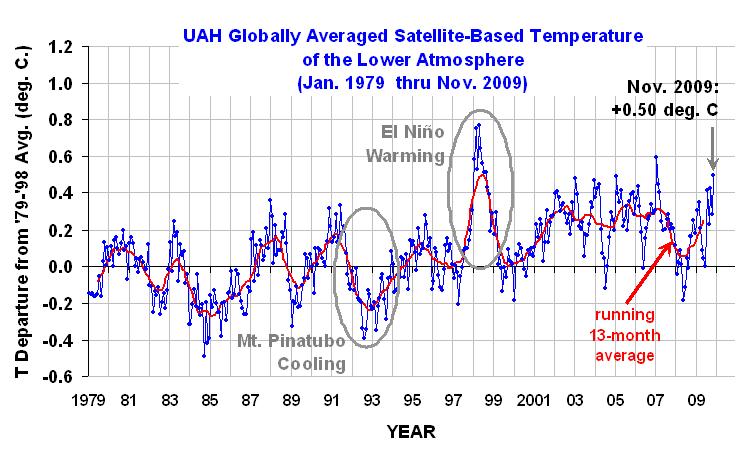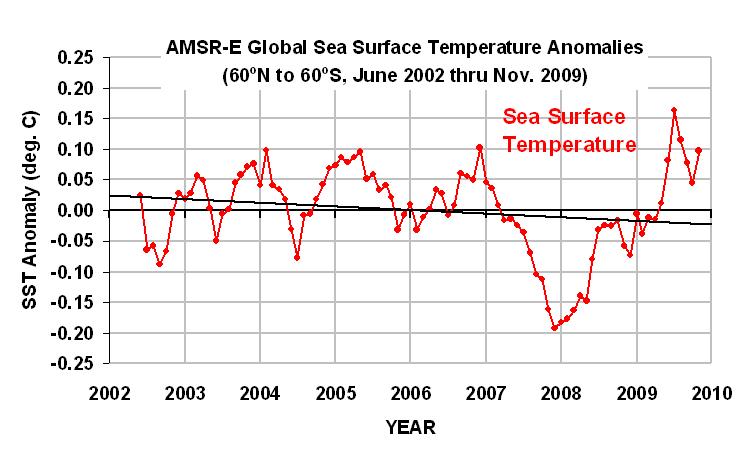It has been two weeks since Climategate revealed that some of the IPCC’s leading researchers have conspired to manipulate temperature data, hide data from other researchers, and bully those scientists who do not agree with them by interfering with the peer review process.
(If you haven’t heard about Climategate, it might be because you are still watching ABC, CBS, or NBC. Google ‘Climategate’, though, and you will get 20,000,000 to 30,000,000 web page matches.)
Supporters have claimed that there is nothing to see there…that the Climategate e-mails released to the world by a whistleblower just show how scientists normally work. This is a particularly bad strategy, and the public knows it. Scientists do NOT behave this way…at least not in my world.
Others have claimed that a few bad apples do not spoil the whole IPCC barrel. Well, if it wasn’t for the fact that these are the core people who gave us the primary thermometer evidence of 20th Century warming (Phil Jones), and the Hockey Stick temperature reconstruction which conveniently did away with the previous 10 or more centuries of natural climate change (Michael Mann), I might be inclined to agree with them.
I will admit that it seems unlikely (but not impossible) that a reanalysis of the thermometer data will lead to a much reduced rate of warming in recent decades. But my bigger concern is that the “it’s-OK-to-fudge” attitude pervades the entire IPCC apparatus.
These e-mails are from the observational side of the IPCC, that is, the research into temperature observations of the past. What I am more concerned about, though, is the manipulation of climate models, which are used to predict the future state of the climate system. Computer models are much easier to manipulate than real data, and one can get just about any answer one wants out of them.
Now that we have seen that the temperature observation guys ‘wanted’ to get a certain result, it is reasonable to wonder whether the modelers are also incentivized to produce particular results. I’m sure the hundreds of millions of dollars being poured into global warming research – money that would dry up if the threat evaporated — has not influenced their objectivity.
Now, trillions of dollars in global warming legislation are riding upon these model ‘black boxes’ that relatively few people understand the inner workings of. The models are so complex, with many adjustable parameters which have no known true values, that it is unlikely that they can ever be replicated by other researchers. In case you hadn’t heard, reproducibility is a basic requirement of scientific research.
The IPCC has gotten around this problem by relying upon many modeling groups running different climate models. The presumption is that the full range of warming estimates produced by 20 different climate models would surely bound the ‘truth’, that is, the true amount of warming that will occur for a given amount of additional greenhouse gas emissions. But do these models really bound the problem?
I’ve been reminded recently that in science you really can not prove any hypothesis to be true; you can only prove a hypothesis false. How does this help us when it comes to model predictions of future warming? Well, if we can not prove whether a model that produces 2, or 4, or 6 deg. C of warming is correct…can we prove whether a model that produces only 0.5 deg. C of warming is false?
If we build a model that produces very little warming – less than that produced by any of the IPCC models – is that model any less realistic in its behavior than the models that produce a lot of warming? In other words, how do we know that the IPCC models really do bound the problem? I suspect that one or more modeling groups have already done this, but the IPCC leadership probably nixed the idea of letting the public find out about it.
Maybe there is a disgruntled modeler out there who is now willing to spill the beans, just as happened with the Climategate emails. We can call it Climategate II.
Of course, the IPCC turns the argument around, and shows us a few models which produce huge amounts of warming. But as I’ve said before, extraordinary claims require extraordinary evidence. If a couple of their models suggest it is theoretically possible to have catastrophic warming, should I be any more concerned than, say, the possibility that a new particle accelerator used by nuclear physicists will suddenly cause the Earth to explode?
While it would be easy to simply not build or use the particle accelerator, it is much more difficult to reduce global fossil fuel use by, say, 50% or more.
In the wake of Climategate, I fully expect a renewed IPCC assault on our common sense using the climate models as their ultimate climate ‘truth’. It will be claimed that the observations involved in Climategate aren’t important anyway…it’s the computer models that are telling us what the future will be.
Yeah, right.

 Home/Blog
Home/Blog





